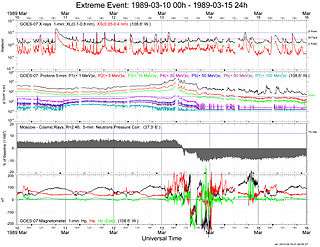March 1989 geomagnetic storm

A severe geomagnetic storm struck Earth on March 13, 1989. It occurred during solar cycle 22 and caused a nine-hour outage of Hydro-Québec's electricity transmission system.
Geomagnetic storm and auroras
The geomagnetic storm causing this event was itself the result of a coronal mass ejection on March 9, 1989.[1] A few days before, on March 6, a very large X15-class solar flare also occurred.[2] Three and a half days later, at 2:44 am EST on March 13, a severe geomagnetic storm struck Earth.[3][4] The storm began on Earth with extremely intense auroras at the poles. The aurora could be seen as far south as Texas and Florida.[5] As this occurred during the Cold War, an unknown number of people worried that a nuclear first strike might be in progress.[5] Others incorrectly considered the intense auroras to be associated with the Space Shuttle mission STS-29, which had been launched on March 13 at 9:57:00 AM.[6] The burst caused short-wave radio interference, including the disruption of radio signals from Radio Free Europe into Russia. It was initially believed that the signals had been jammed by the Soviet government.
As midnight came and went, a river of charged particles and electrons in the ionosphere flowed from west to east, inducing powerful electrical currents in the ground that surged into many natural nooks and crannies.[5]
Some satellites in polar orbits lost control for several hours. GOES weather satellite communications were interrupted, causing weather images to be lost. NASA's TDRS-1 communication satellite recorded over 250 anomalies caused by the increased particles flowing into its sensitive electronics.[5] The Space Shuttle Discovery was having its own problems: a sensor on one of the tanks supplying hydrogen to a fuel cell was showing unusually high pressure readings on March 13. The problem went away after the solar storm subsided.
Anecdotal evidence suggests that one of the UK's nuclear submarines noticed a variation in ELF signal strength around the same time, as the MoD files are still classified this is not yet possible to confirm or deny.
Quebec blackout

The variations in the earth's magnetic field also tripped circuit breakers on Hydro-Québec's power grid. The utility's very long transmission lines and the fact that most of Quebec sits on a large rock shield prevented current flowing through the earth, finding a less resistant path along the 735 kV power lines.[8]
The James Bay network went offline in less than 90 seconds, giving Quebec its second massive blackout in 11 months.[9] The power failure lasted nine hours and forced the company to implement various mitigation strategies, including raising the trip level, installing series compensation on ultra high voltage lines and upgrading various monitoring and operational procedures. Other utilities in North America and Northern Europe and elsewhere implemented programs to reduce the risks associated with geomagnetically induced currents.[8]
Military
One of the few publicly reported military operations impacted was the Australian Army component of the United Nations (UN) peacekeeping force which was deployed to Namibia at the time. The storm occurred just as the advance elements of the contingent arrived in Namibia, but the effects were believed to last for weeks afterwards. The Australian contribution to UNTAG was heavily reliant on HF radio communications which were severely impacted.[10][11]
Aftermath
In August 1989, another storm caused a halt of all trading on Toronto's stock market.[12]
Since 1995, geomagnetic storms and solar flares have been monitored from the Solar and Heliospheric Observatory (SOHO) satellite, a joint project of NASA and the European Space Agency.
Because of serious concerns that utilities have failed to set protection standards and are unprepared for a severe solar storm such as a Carrington Event, the Federal Energy Regulatory Commission (FERC) is now (as of 2013) in the process of a proposed ruling that may require utilities to create a standard that would require power grids to be protected from severe solar storms.[13] Similarly, the Nuclear Regulatory Commission has begun a phased rule-making, published in the Federal Register, to examine the sufficiency of cooling systems of stored spent fuel rods of nuclear power plants now considered vulnerable to long-term power outages from events such as space weather, high-altitude nuclear burst electromagnetic pulses or cyber attacks.[14]
See also
References
- ↑ Geomagnetic Storms Can Threaten Electric Power Grid Earth in Space, Vol. 9, No. 7, March 1997, pp.9-11 (American Geophysical Union)
- ↑ http://sohowww.nascom.nasa.gov/hotshots/X17/
- ↑ Lerner, Eric J. (August 1995). "Space weather: Page 1". Discover. Retrieved 2008-01-20.
- ↑ "Scientists probe northern lights from all angles". CBC News. 2005-10-22. Retrieved 2008-01-13.
- 1 2 3 4 "A Conflagration of Storms". Retrieved 2009-04-07.
- ↑ "STS-29". Science.ksc.nasa.gov. Retrieved 2010-08-09.
- ↑ "Extreme Space Weather Events". National Geophysical Data Center.
- 1 2 Hydro-Québec. "Understanding Electricity - March 1989 - Hydro-Québec". Retrieved 2010-10-25.
- ↑ Morin, Michel; Sirois, Gilles; Derome, Bernard (13 March 1989). "Le Québec dans le noir" (in French). Radio-Canada. Retrieved 2009-03-21.
- ↑ Horner, David (2011). Australia and the New World Order: The Official History of Australian Peacekeeping, Humanitarian and Post-Cold War Operations. From Peacekeeping to Peace Enforcement: 1988–1991. 2. Cambridge University Press. ISBN 978-0-521-76587-9. Retrieved 29 July 2012.
- ↑ Sowry, Brendan, ed. (1992). United Nations Transition Assistance Group (UNTAG) in Namibia. Training Information Bulletin Number 63. Australian Army.
- ↑ Solar storms halt stock market as computers crash, New Scientist, 9 September 1989.
- ↑ Federal Energy Regulatory Commission. Transmission Planning and Cost Allocation by Transmission Owning and Operating Public Utilities. Retrieved 2013-04-23.
- ↑ 77 FR 16175